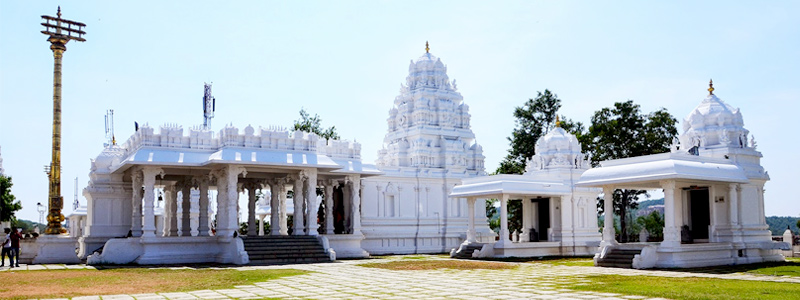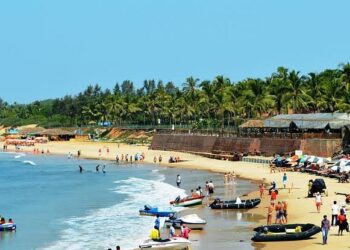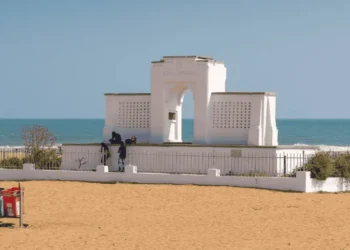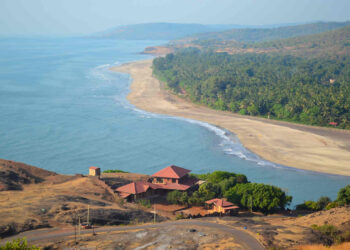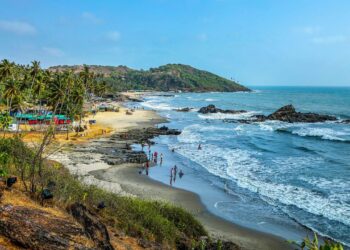Sanghi Temple in Hyderabad, Telengana is dedicated to Lord Venkateswara, a form of Sri Vishnu. Set on Paramanand Giri hill in Sanghi Nagar, about 35 km from Hyderabad’s busy streets, it is is said to be the replica of Tirumala temple. The temple covers about 10 acres, and was built in 1991, decorated with gopurams and temple structures having a mix of both Chola and Chalukya styles, pulling in devotees and visitors from all over India.
Legend of the Temple
The Sanghi Temple is centered on Lord Venkateswara, a form of Lord Vishnu, believed to grace devotees with wealth and prosperity. The 9.5-foot idol, like the one in Tirumala, stands for divine grace. Local stories say the Sanghi family built the temple after a holy vision, wanting to bring Tirumala’s sacredness to Hyderabad. The temple’s shrines for Padmavati, Shiva, Rama, and others link it to wide Hindu worship, offering many ways to pray. People believe praying here brings success and clears troubles, making it a top Vishnu shrine in Telangana.
Historical Overview
The Sanghi Temple is new compared to Telangana’s ancient shrines, with work starting on February 25, 1991, led by the Sanghi Group, a big Hyderabad business family. Guided by Shri Ravi Sanghi and the late Shri Ram Sharan’s dream, the temple was finished in just 18 months, a sign of strong faith. The foundation stone was laid with blessings from Jayendra Saraswati Swamiji of Kanchi Kamakoti Peetam and noted sculptor Shri Ganapathy Sthapathy shaped it in the Chola-Chalukya style.
Temple Structure and Design
The Sanghi Temple in Hyderabad, Telangana, is built in a fine Chola-Chalukya style, mixing South Indian and Dravidian art with new beauty. The temple’s 15-foot Raja Gopuram, seen from far away, tops the hill with carvings of Vishnu with his conch, Shiva with his trident, and divine dancers with lotus designs, painted in clean white marble. A big Maha Dwaram, with stone elephant heads on the stairway, leads to the main area. The sanctum holds a 9.5-foot Lord Venkateswara idol, carved with care, draped in gold cloth and fresh garlands, set under a golden vimana that shines with oil lamps. The sanctum’s marble walls glow with paintings of Vishnu’s tales, adding sacred light.
Small shrines for Padmavati, Shiva, Rama, Anjaneya, Ganesha, Kartikeya, Durga, Ashtalakshmi, and Navagrahas are placed around, each carved from marble with open roofs. The Padmavati shrine, to the right, shows the goddess on a lotus, holding flowers for love. The Shiva shrine, near the entrance, has a lingam with snake designs, tied to old worship. The Anjaneya shrine, at the hill’s base, shows Hanuman as Kshetra Palak, guarding the temple with folded hands. These shrines, though small, weave a rich web of devotion, calling for many prayers.
Set on Paramanand Giri, the temple can be reached by a long set of marble steps. The hilltop courtyard, paved with smooth granite is decorated with neat lawns and neem trees giving shade. A Pavitra Vanam, or holy garden, grows tulsi and flowers for rituals, adding to the calm environment. A Kalyana Mandapam, with a carved roof, hosts weddings, matching the temple’s look. Carvings on pillars show Vishnu’s stories—his Narasimha form, his Krishna life—etched to guide devotees.
Rituals and Festivals
Brahmotsavam, held each year, is the biggest celebration in the temple, with bright marches and rituals drawing thousands. Kalyanam rituals are performed in Sri Rama Navami around March/April, while during Vaikuntha Ekadashi in December or January devotees kake up fasts and devotional chants. Maha Shivaratri in February/ March honors Shiva with homams, and Vinayaka Chaturthi celebrates Ganesha with modak gifts.
Pujas and sevas, like Abhishekam, happen from 6:00 PM to 8:00 PM. Weekly Abhishekam is held for Ramalingeswara on Mondays, Hanuman on Tuesdays, and Venkateswara, Ashtalakshmi, Parvathi, Padmavathi, and Rama on Fridays. Devotees can book sevas at the office for 100-1000 rupees. A prasad counter gives jaggery sweets for a small fee. The temple closes from 12:00 PM to 4:00 PM and after 8:00 PM.
Information for Travelers
Hours and Entry: Open daily, 8:00 AM to 1:00 PM and 4:00 PM to 8:00 PM (Monday–Saturday); 8:00 AM to 8:00 PM on Sundays, festivals, and holidays. Entry is free for devotees, but sevas can cost anywhere from 100 to1000 rupees.
Clothing: Wear simple clothes covering shoulders and knees. Men doing rituals wear dhotis, often bare-chested, as custom. No footwear is allowed inside.
How to Get There:
Air: Rajiv Gandhi International Airport, 36 km away, is nearest. Taxis take 45-60 minutes, costing 1000-1500 rupees.
Train: Hyderabad Deccan (Nampally) or Kachiguda Railway Station, 30 km away, links to big cities. Autos or taxis cost 500-800 rupees.
Road: Sanghi Nagar is 35 km from Hyderabad. TSRTC buses (routes 290S, 205K) from Secunderabad or L.B. Nagar take 1-1.5 hours. Autos from Sanghi Nagar cost 20-50 rupees.
Places to Stay: The temple has a guesthouse for short stays. Hyderabad, 35 km away, has hotels like Plaza Hotel, Begumpet (2000-5000 rupees). Sanghi Nagar has no big hotels; day trips are common. Stalls sell dosa, idli, and tea.
Best Time to Visit: October to February has cool weather, 20-30°C, good for visits. Weekdays are calm; festivals like Brahmotsavam bring crowds, so book early. Sunrise or sunset visits give fine views.
Nearby Attractions: Ramoji Film City, 15 km away, is a big film studio hub. Chilkur Balaji Temple, 18 km away, is known as the “Visa Balaji” shrine. Golkonda Fort, 25 km away, offers history and a sound-light show.
